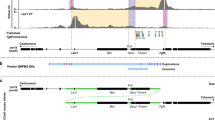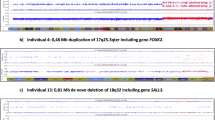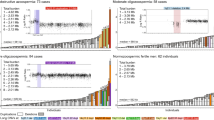Abstract
Split hand/foot malformation (SHFM) is a congenital limb deficiency with missing or shortened central digits. Some SHFM genes have been identified but the cause of many SHFM cases is unknown. We used single-nucleotide polymorphism (SNP) microarray analysis to detect copy-number variants (CNVs) in 25 SHFM cases without other birth defects from New York State (NYS), prioritized CNVs absent from population CNV databases, and validated these CNVs using quantitative real-time polymerase chain reaction (qPCR). We tested for the validated CNVs in seven cases from Iowa using qPCR, and also sequenced 36 SHFM candidate genes in all the subjects. Seven NYS cases had a potentially deleterious variant: two had a p.R225H or p.R225L mutation in TP63, one had a 17q25 microdeletion, one had a 10q24 microduplication and three had a 17p13.3 microduplication. In addition, one Iowa case had a de novo 10q24 microduplication. The 17q25 microdeletion has not been reported previously in SHFM and included two SHFM candidate genes (SUMO2 and GRB2), while the 10q24 and 17p13.3 CNVs had breakpoints within genomic regions that contained putative regulatory elements and a limb development gene. In SHFM pathogenesis, the microdeletion may cause haploinsufficiency of SHFM genes and/or deletion of their regulatory regions, and the microduplications could disrupt regulatory elements that control transcription of limb development genes.
Similar content being viewed by others
Log in or create a free account to read this content
Gain free access to this article, as well as selected content from this journal and more on nature.com
or
References
Gurrieri, F. & Everman, D. B. Clinical, genetic, and molecular aspects of split-hand/foot malformation: an update. Am. J. Med. Genet. A 161A, 2860–2872 (2013).
Froster-Iskenius, U. G. & Baird, P. A. Limb reduction defects in over one million consecutive livebirths. Teratology 39, 127–135 (1989).
Stoll, C., Calzolari, E., Cornel, M., Garcia-Minaur, S., Garne, E., Nevin, N. et al. A study on limb reduction defects in six European regions. Ann. Genet. 39, 99–104 (1996).
Bedard, T., Lowry, R. B., Sibbald, B., Kiefer, G. N. & Metcalfe, A. Congenital limb deficiencies in Alberta-a review of 33 years (1980-2012) from the Alberta Congenital Anomalies Surveillance System (ACASS). Am. J. Med. Genet. A 167A, 2599–2609 (2015).
van Bokhoven, H., Hamel, B. C., Bamshad, M., Sangiorgi, E., Gurrieri, F., Duijf, P. H. et al. p63 Gene mutations in eec syndrome, limb-mammary syndrome, and isolated split hand-split foot malformation suggest a genotype-phenotype correlation. Am. J. Hum. Genet. 69, 481–492 (2001).
Khan, S., Basit, S., Zimri, F. K., Ali, N., Ali, G., Ansar, M. et al. A novel homozygous missense mutation in WNT10B in familial split-hand/foot malformation. Clin. Genet. 82, 48–55 (2012).
Fernandez-Teran, M. & Ros, M. A. The Apical Ectodermal Ridge: morphological aspects and signaling pathways. Int. J. Dev. Biol. 52, 857–871 (2008).
Duijf, P. H., van Bokhoven, H. & Brunner, H. G. Pathogenesis of split-hand/split-foot malformation. Hum. Mol. Genet. 12 (Spec No 1), R51–R60 (2003).
Kelley, R. O. Early development of the vertebrate limb: an introduction to morphogenetic tissue interactions using scanning electron microscopy. Scan. Electron Microsc. Pt 2, 827–836 (1985).
Al-Qattan, M. M. & Kozin, S. H. Update on embryology of the upper limb. J. Hand Surg. Am. 38, 1835–1844 (2013).
Kjaer, K. W., Hansen, L., Schwabe, G. C., Marques-de-Faria, A. P., Eiberg, H., Mundlos, S. et al. Distinct CDH3 mutations cause ectodermal dysplasia, ectrodactyly, macular dystrophy (EEM syndrome). J. Med. Genet. 42, 292–298 (2005).
Shamseldin, H. E., Faden, M. A., Alashram, W. & Alkuraya, F. S. Identification of a novel DLX5 mutation in a family with autosomal recessive split hand and foot malformation. J. Med. Genet. 49, 16–20 (2012).
Simonis, N., Migeotte, I., Lambert, N., Perazzolo, C., de Silva, D. C., Dimitrov, B. et al. FGFR1 mutations cause Hartsfield syndrome, the unique association of holoprosencephaly and ectrodactyly. J. Med. Genet. 50, 585–592 (2013).
Barnett, C. P., Nataren, N. J., Klingler-Hoffmann, M., Schwarz, Q., Chong, C. E., Lee, Y. K. et al. Ectrodactyly and lethal pulmonary acinar dysplasia associated with homozygous FGFR2 mutations identified by exome sequencing. Hum. Mutat. 37, 955–963 (2016).
Spielmann, M., Kakar, N., Tayebi, N., Leettola, C., Nurnberg, G., Sowada, N. et al. Exome sequencing and CRISPR/Cas genome editing identify mutations of ZAK as a cause of limb defects in humans and mice. Genome Res. 26, 183–191 (2016).
Kano, H., Kurosawa, K., Horii, E., Ikegawa, S., Yoshikawa, H., Kurahashi, H. et al. Genomic rearrangement at 10q24 in non-syndromic split-hand/split-foot malformation. Hum. Genet. 118, 477–483 (2005).
Armour, C. M., Bulman, D. E., Jarinova, O., Rogers, R. C., Clarkson, K. B., DuPont, B. R. et al. 17p13.3 microduplications are associated with split-hand/foot malformation and long-bone deficiency (SHFLD). Eur. J. Hum. Genet. 19, 1144–1151 (2011).
Theisen, A., Rosenfeld, J. A., Shane, K., McBride, K. L., Atkin, J. F., Gaba, C. et al. Refinement of the region for split hand/foot malformation 5 on 2q31.1. Mol. Syndromol. 1, 262–271 (2010).
Corona-Rivera, A., Corona-Rivera, J. R., Bobadilla-Morales, L., Garcia-Cobian, T. A. & Corona-Rivera, E. Holoprosencephaly, hypertelorism, and ectrodactyly in a boy with an apparently balanced de novo t(2;4) (q14.2;q35). Am. J. Med. Genet. 90, 423–426 (2000).
Correa-Cerro, L., Garciaz-Cruz, D., Diaz-Castanos, L., Figuera, L. E. & Sanchez-Corona, J. Interstitial deletion 6q16.2q22.2 in a child with ectrodactyly. Ann. Genet. 39, 105–109 (1996).
Faiyaz ul Haque, M., Uhlhaas, S., Knapp, M., Schuler, H., Friedl, W., Ahmad, M. et al. Mapping of the gene for X-chromosomal split-hand/split-foot anomaly to Xq26-q26.1. Hum. Genet. 91, 17–19 (1993).
Wang, Y., Sharpe-Stimac, M., Cross, P. K., Druschel, C. M. & Hwang, S. A. Improving case ascertainment of a population-based birth defects registry in New York State using hospital discharge data. Birth Defects Res. A Clin. Mol. Teratol. 73, 663–668 (2005).
Saavedra-Matiz, C. A., Isabelle, J. T., Biski, C. K., Duva, S. J., Sweeney, M. L., Parker, A. L. et al. Cost-effective and scalable DNA extraction method from dried blood spots. Clin. Chem. 59, 1045–1051 (2013).
Yoon, P. W., Rasmussen, S. A., Lynberg, M. C., Moore, C. A., Anderka, M., Carmichael, S. L. et al. The National Birth Defects Prevention Study. Public Health Rep. 116 (Suppl 1), 32–40 (2001).
Wang, K., Li, M., Hadley, D., Liu, R., Glessner, J., Grant, S. F. et al. PennCNV: an integrated hidden Markov model designed for high-resolution copy number variation detection in whole-genome SNP genotyping data. Genome Res. 17, 1665–1674 (2007).
Consortium, I. H. The International HapMap Project. Nature 426, 789–796 (2003).
Shaikh, T. H., Gai, X., Perin, J. C., Glessner, J. T., Xie, H., Murphy, K. et al. High-resolution mapping and analysis of copy number variations in the human genome: a data resource for clinical and research applications. Genome Res. 19, 1682–1690 (2009).
MacDonald, J. R., Ziman, R., Yuen, R. K., Feuk, L. & Scherer, S. W. The Database of Genomic Variants: a curated collection of structural variation in the human genome. Nucleic Acids Res. 42, D986–D992 (2014).
Harrow, J., Frankish, A., Gonzalez, J. M., Tapanari, E., Diekhans, M., Kokocinski, F. et al. GENCODE: the reference human genome annotation for The ENCODE Project. Genome Res. 22, 1760–1774 (2012).
Hamosh, A., Scott, A. F., Amberger, J. S., Bocchini, C. A. & McKusick, V. A. Online Mendelian Inheritance in Man (OMIM), a knowledgebase of human genes and genetic disorders. Nucleic Acids Res. 33, D514–D517 (2005).
Miller, D. T., Adam, M. P., Aradhya, S., Biesecker, L. G., Brothman, A. R., Carter, N. P. et al. Consensus statement: chromosomal microarray is a first-tier clinical diagnostic test for individuals with developmental disabilities or congenital anomalies. Am. J. Hum. Genet. 86, 749–764 (2010).
Rosenbloom, K. R., Armstrong, J., Barber, G. P., Casper, J., Clawson, H., Diekhans, M. et al. The UCSC Genome Browser database: 2015 update. Nucleic Acids Res. 43, D670–D681 (2015).
Firth, H. V., Richards, S. M., Bevan, A. P., Clayton, S., Corpas, M., Rajan, D. et al. DECIPHER: database of chromosomal imbalance and phenotype in humans using Ensembl resources. Am. J. Hum. Genet. 84, 524–533 (2009).
Wang, K., Li, M. & Hakonarson, H. ANNOVAR: functional annotation of genetic variants from high-throughput sequencing data. Nucleic Acids Res. 38, e164 (2010).
Lek, M., Karczewski, K. J., Minikel, E. V., Samocha, K. E., Banks, E., Fennell, T. et al. Analysis of protein-coding genetic variation in 60,706 humans. Nature 536, 285–291 (2016).
Cotney, J., Leng, J., Yin, J., Reilly, S. K., DeMare, L. E., Emera, D. et al. The evolution of lineage-specific regulatory activities in the human embryonic limb. Cell 154, 185–196 (2013).
DeMare, L. E., Leng, J., Cotney, J., Reilly, S. K., Yin, J., Sarro, R. et al. The genomic landscape of cohesin-associated chromatin interactions. Genome Res. 23, 1224–1234 (2013).
Beermann, F., Kaloulis, K., Hofmann, D., Murisier, F., Bucher, P. & Trumpp, A. Identification of evolutionarily conserved regulatory elements in the mouse Fgf8 locus. Genesis 44, 1–6 (2006).
Komisarczuk, A. Z., Kawakami, K. & Becker, T. S. Cis-regulation and chromosomal rearrangement of the fgf8 locus after the teleost/tetrapod split. Dev. Biol. 336, 301–312 (2009).
Marinic, M., Aktas, T., Ruf, S. & Spitz, F. An integrated holo-enhancer unit defines tissue and gene specificity of the Fgf8 regulatory landscape. Dev. Cell 24, 530–542 (2013).
Creyghton, M. P., Cheng, A. W., Welstead, G. G., Kooistra, T., Carey, B. W., Steine, E. J. et al. Histone H3K27ac separates active from poised enhancers and predicts developmental state. Proc. Natl Acad. Sci. USA 107, 21931–21936 (2010).
Elliott, A. M., Reed, M. H., Chudley, A. E., Chodirker, B. N. & Evans, J. A. Clinical and epidemiological findings in patients with central ray deficiency: split hand foot malformation (SHFM) in Manitoba, Canada. Am. J. Med. Genet. A 140, 1428–1439 (2006).
Everman, D. B., Morgan, C. T., Lyle, R., Laughridge, M. E., Bamshad, M. J., Clarkson, K. B. et al. Frequency of genomic rearrangements involving the SHFM3 locus at chromosome 10q24 in syndromic and non-syndromic split-hand/foot malformation. Am. J. Med. Genet. A 140, 1375–1383 (2006).
Dimitrov, B. I., de Ravel, T., Van Driessche, J., de Die-Smulders, C., Toutain, A., Vermeesch, J. R. et al. Distal limb deficiencies, micrognathia syndrome, and syndromic forms of split hand foot malformation (SHFM) are caused by chromosome 10q genomic rearrangements. J. Med. Genet. 47, 103–111 (2010).
Klopocki, E., Lohan, S., Doelken, S. C., Stricker, S., Ockeloen, C. W., Soares Thiele de Aguiar, R. et al. Duplications of BHLHA9 are associated with ectrodactyly and tibia hemimelia inherited in non-Mendelian fashion. J. Med. Genet. 49, 119–125 (2012).
Nagata, E., Kano, H., Kato, F., Yamaguchi, R., Nakashima, S., Takayama, S. et al. Japanese founder duplications/triplications involving BHLHA9 are associated with split-hand/foot malformation with or without long bone deficiency and Gollop-Wolfgang complex. Orphanet J. Rare Dis. 9, 125 (2014).
Petit, F., Jourdain, A. S., Andrieux, J., Baujat, G., Baumann, C., Beneteau, C. et al. Split hand/foot malformation with long-bone deficiency and BHLHA9 duplication: report of 13 new families. Clin. Genet. 85, 464–469 (2014).
de Mollerat, X. J., Everman, D. B., Morgan, C. T., Clarkson, K. B., Rogers, R. C., Colby, R. S. et al. P63 mutations are not a major cause of non-syndromic split hand/foot malformation. J. Med. Genet. 40, 55–61 (2003).
Celli, J., Duijf, P., Hamel, B. C., Bamshad, M., Kramer, B., Smits, A. P. et al. Heterozygous germline mutations in the p53 homolog p63 are the cause of EEC syndrome. Cell 99, 143–153 (1999).
Koster, M. I., Kim, S., Mills, A. A., DeMayo, F. J. & Roop, D. R. p63 is the molecular switch for initiation of an epithelial stratification program. Genes Dev. 18, 126–131 (2004).
Lo Iacono, N., Mantero, S., Chiarelli, A., Garcia, E., Mills, A. A., Morasso, M. I. et al. Regulation of Dlx5 and Dlx6 gene expression by p63 is involved in EEC and SHFM congenital limb defects. Development 135, 1377–1388 (2008).
Mills, A. A., Zheng, B., Wang, X. J., Vogel, H., Roop, D. R. & Bradley, A. p63 is a p53 homologue required for limb and epidermal morphogenesis. Nature 398, 708–713 (1999).
Yang, A., Schweitzer, R., Sun, D., Kaghad, M., Walker, N., Bronson, R. T. et al. p63 is essential for regenerative proliferation in limb, craniofacial and epithelial development. Nature 398, 714–718 (1999).
Ghioni, P., D'Alessandra, Y., Mansueto, G., Jaffray, E., Hay, R. T., La Mantia, G. et al. The protein stability and transcriptional activity of p63alpha are regulated by SUMO-1 conjugation. Cell Cycle 4, 183–190 (2005).
Huang, Y. P., Wu, G., Guo, Z., Osada, M., Fomenkov, T., Park, H. L. et al. Altered sumoylation of p63alpha contributes to the split-hand/foot malformation phenotype. Cell Cycle 3, 1587–1596 (2004).
Lin, C. C., Melo, F. A., Ghosh, R., Suen, K. M., Stagg, L. J., Kirkpatrick, J. et al. Inhibition of basal FGF receptor signaling by dimeric Grb2. Cell 149, 1514–1524 (2012).
Crossley, P. H. & Martin, G. R. The mouse Fgf8 gene encodes a family of polypeptides and is expressed in regions that direct outgrowth and patterning in the developing embryo. Development 121, 439–451 (1995).
Moon, A. M. & Capecchi, M. R. Fgf8 is required for outgrowth and patterning of the limbs. Nat. Genet. 26, 455–459 (2000).
Lewandoski, M., Sun, X. & Martin, G. R. Fgf8 signalling from the AER is essential for normal limb development. Nat. Genet. 26, 460–463 (2000).
Kano, H., Kurahashi, H. & Toda, T. Genetically regulated epigenetic transcriptional activation of retrotransposon insertion confers mouse dactylaplasia phenotype. Proc. Natl Acad. Sci. USA 104, 19034–19039 (2007).
Seto, M. L., Nunes, M. E., MacArthur, C. A. & Cunningham, M. L. Pathogenesis of ectrodactyly in the Dactylaplasia mouse: aberrant cell death of the apical ectodermal ridge. Teratology 56, 262–270 (1997).
Malik, S., Percin, F. E., Bornholdt, D., Albrecht, B., Percesepe, A., Koch, M. C. et al. Mutations affecting the BHLHA9 DNA-binding domain cause MSSD, mesoaxial synostotic syndactyly with phalangeal reduction, Malik-Percin type. Am. J. Hum. Genet. 95, 649–659 (2014).
Phadke, S. R., Kar, A., Bhowmik, A. D. & Dalal, A. Complex camptosynpolydactyly and mesoaxial synostotic syndactyly with phalangeal reduction are allelic disorders. Am. J. Med. Genet. A 170, 1622–1625 (2016).
Schatz, O., Langer, E. & Ben-Arie, N. Gene dosage of the transcription factor Fingerin (bHLHA9) affects digit development and links syndactyly to ectrodactyly. Hum. Mol. Genet. 23, 5394–5401 (2014).
Curry, C. J., Rosenfeld, J. A., Grant, E., Gripp, K. W., Anderson, C., Aylsworth, A. S. et al. The duplication 17p13.3 phenotype: analysis of 21 families delineates developmental, behavioral and brain abnormalities, and rare variant phenotypes. Am. J. Med. Genet. A 161A, 1833–1852 (2013).
Al Kaissi, A., Ganger, R., Rotzer, K. M., Klaushofer, K. & Grill, F. A child with split-hand/foot associated with tibial hemimelia (SHFLD syndrome) and thrombocytopenia maps to chromosome region 17p13.3. Am. J. Med. Genet. A 164A, 2338–2343 (2014).
Filho, A. B., Souza, J., Faucz, F. R., Sotomaior, V. S., Dupont, B., Bartel, F. et al. Somatic/gonadal mosaicism in a syndromic form of ectrodactyly, including eye abnormalities, documented through array-based comparative genomic hybridization. Am. J. Med. Genet. A 155A, 1152–1156 (2011).
Petit, F., Andrieux, J., Demeer, B., Collet, L. M., Copin, H., Boudry-Labis, E. et al. Split-hand/foot malformation with long-bone deficiency and BHLHA9 duplication: two cases and expansion of the phenotype to radial agenesis. Eur. J. Med. Genet. 56, 88–92 (2013).
Johnson, K. R., Lane, P. W., Ward-Bailey, P. & Davisson, M. T. Mapping the mouse dactylaplasia mutation, Dac, and a gene that controls its expression, mdac. Genomics 29, 457–464 (1995).
Rattanasopha, S., Tongkobpetch, S., Srichomthong, C., Kitidumrongsook, P., Suphapeetiporn, K. & Shotelersuk, V. Absent expression of the osteoblast-specific maternally imprinted genes, DLX5 and DLX6, causes split hand/split foot malformation type I. J. Med. Genet. 51, 817–823 (2014).
Acknowledgements
We thank Matthew Shudt and Zhen Zhang at the Wadsworth Center Applied Genomics Technologies Core, New York State Department of Health, for next-generation sequencing; April Atkins and Emily McGrath at the Wadsworth Center, New York State Department of Health, for technical assistance; and Nathan Pankratz, University of Minnesota, and Karl G. Hill, Social Development Research Group, University of Washington, for generously sharing population B-allele frequency and GC content files for PennCNV software. This work was funded by the Intramural Research Program of the National Institutes of Health, Eunice Kennedy Shriver National Institute of Child Health and Human Development (Contracts HHSN275201100001I, HHSN27500005 and N01-DK-73431) and the Iowa Center for Birth Defects Research and Prevention (5U01DD001035).
Author information
Authors and Affiliations
Corresponding author
Ethics declarations
Competing interests
The authors declare no conflict of interest.
Additional information
Supplementary Information accompanies the paper on Journal of Human Genetics website
Supplementary information
Rights and permissions
About this article
Cite this article
Carter, T., Sicko, R., Kay, D. et al. Copy-number variants and candidate gene mutations in isolated split hand/foot malformation. J Hum Genet 62, 877–884 (2017). https://doi.org/10.1038/jhg.2017.56
Received:
Revised:
Accepted:
Published:
Issue date:
DOI: https://doi.org/10.1038/jhg.2017.56
This article is cited by
-
A new case of 17p13.3p13.1 microduplication resulted from unbalanced translocation: clinical and molecular cytogenetic characterization
Molecular Cytogenetics (2021)
-
Little to Give, Much to Gain—What Can You Do With a Dried Blood Spot?
Current Environmental Health Reports (2020)
-
Split hand/foot malformation with long bone deficiency associated with BHLHA9 gene duplication: a case report and review of literature
BMC Medical Genetics (2019)
-
Comprehensive clinical and molecular studies in split-hand/foot malformation: identification of two plausible candidate genes (LRP6 and UBA2)
European Journal of Human Genetics (2019)
-
Duplication of 10q24 locus: broadening the clinical and radiological spectrum
European Journal of Human Genetics (2019)



